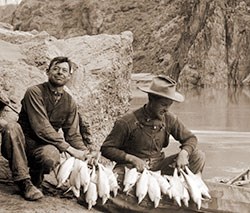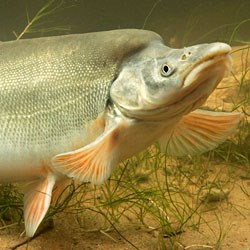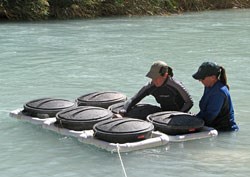
Illustration by Joe Tomelleri
Humpback Chub (Gila cypha) Status: Endangered Humpback chub are one of three species of chub that once inhabited the canyon, and are the only chub species still found in Grand Canyon. Even though the species is listed as endangered, populations of humpback chub are found in eight reaches of the Colorado River basin in western Colorado, Utah, and Grand Canyon. The largest of these populations is in Grand Canyon National Park. In fact, the confluence of the Colorado and Little Colorado Rivers in Grand Canyon supports the largest of the six remaining populations of humpback chub in the world. According to a 2009 population estimate by the US Geological Survey's Grand Canyon Monitoring and Research Center, between 6,000 and 10,000 humpback chub live in Grand Canyon. 
GRCA #15774 (Rust Collection) "After the snow melts the Colorado backs up into some of those small canons and the fish come in millions….They are so thick that you can lean over the water's edge and pull them out by the tail two at a time…. They are about twenty inches long and have a flat hump on their back just behind the head."

Bruce Taubert, Arizona Game and Fish Humpback chub live as long as 30 years or more and reach lengths of up to 20 inches (500 mm). The species inhabits whitewater reaches of deep canyons. Because of the ruggedness and remoteness of their canyon habitat, humpback chub was the last species of Colorado River native fish to be scientifically described. It wasn't until 1946, when several specimens, including one captured in or near Bright Angel Creek, was first described in the scientific literature.

Ron Chapple Photography The Little Colorado River aggregation is the only known spawning population of humpback chub in Grand Canyon. Humpback chub require water temperatures of at least 61º F to spawn. Since Glen Canyon Dam draws water from deep beneath the surface of Lake Powell, the Colorado River is now too cold for humpback chub to spawn in most years, except near warm water springs such as near River Mile 30. Fish predator-prey relationships are complex, but the humpback chub's primary predator historically was likely the Colorado River pikeminnow. Because of the high turbidity of the Colorado River prior to the construction of Glen Canyon Dam, humpback chub are not adapted to "sight predators" such as non-native rainbow and brown trout. Studies conducted by the US Geological Survey found that humpback chub and other native fish were the most likely fish prey that trout consumed in the Colorado River near the Little Colorado River. 
NPS photo by Melissa Trammell Current conservation measures for the recovery of humpback chub in Grand Canyon include translocations of humpback chub into tributaries, non-native fish control, and the establishment of a refuge population of humpback chub at US Fish and Wildlife Service fish hatchery in New Mexico. |
Last updated: February 24, 2015
